Catering Services Market OverviewThe global catering services market is poised for substantial growth, driven by an increasing demand for food services in both corporate and private sectors. Rising disposable income, evolving consumer preferences for personalized dining experiences, and the growing trend of outsourcing food services in industries like hospitality, healthcare, and events are the key drivers. Catering services are expanding beyond traditional offerings to include more diverse and health-conscious options, such as vegan and gluten-free menus, reflecting the shift in consumer preferences toward healthier eating.This expanding market is also embracing technology, with digital tools and automation transforming service delivery and enhancing customer experiences. This includes the use of mobile apps for ordering, delivery tracking, and menu customization. Additionally, advancements in sustainability are driving market growth, with catering businesses incorporating eco-friendly practices such as reducing food waste, using biodegradable packaging, and sourcing locally produced ingredients.The outlook for the catering services market is optimistic, with several key trends and projections indicating continued growth through 2032:
- Market Size: The global catering services market is expected to reach approximately USD 290 billion by 2032, reflecting a compound annual growth rate (CAGR) of about 7.2% from 2024 to 2032.
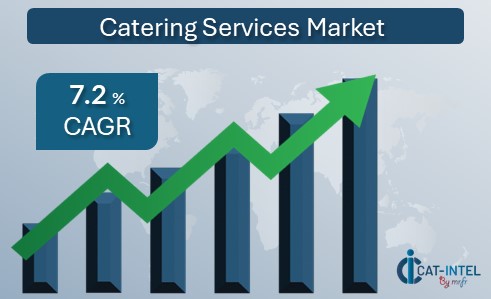
- Corporate and Business Catering: With the increasing demand for employee welfare and corporate events, there is a rising need for catering services in office settings, conferences, and business meetings.
- Event Catering: The demand for catering services in weddings, festivals, and other private events continues to rise, driven by consumer preference for convenience and high-quality food offerings.
- Healthcare Catering: The healthcare sector is increasingly relying on outsourced catering services to meet the dietary needs of patients, offering tailored meal plans for specific health conditions.
- Sustainability Initiatives: Catering companies are increasingly adopting sustainability practices such as reducing food waste, sourcing sustainable ingredients, and using environmentally friendly packaging.
- Health-Conscious Trends: The demand for healthier meal options is growing, with catering businesses offering vegan, vegetarian, gluten-free, and allergen-free options to meet dietary preferences.
- Customization and Personalization: Clients are increasingly seeking personalized catering services that cater to specific tastes, dietary needs, and event themes, prompting businesses to offer more flexible and customizable menus.
- Health and Wellness: A growing awareness of nutrition and health is boosting the demand for healthier food options in catering services.
- Corporate Demand: Companies are increasingly outsourcing their catering needs for employee meals, corporate meetings, and events, contributing to market growth.
- Event Growth: With the increasing number of weddings, festivals, and private events, the demand for high-quality catering services is on the rise.
- Sustainability Awareness: Catering services that focus on sustainable practices are gaining a competitive edge, attracting eco-conscious consumers and businesses.
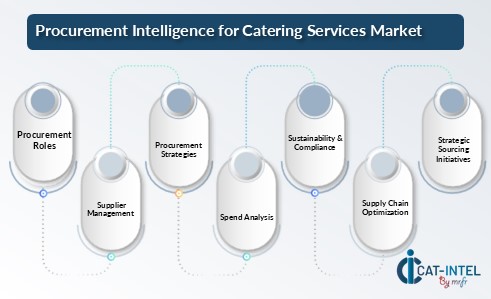
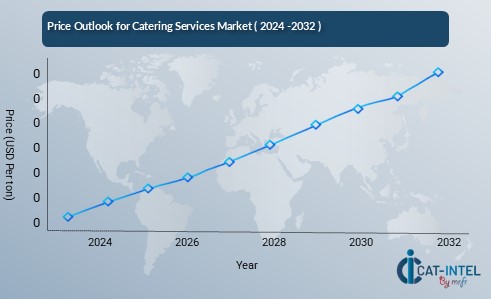 Our analysis highlights the following factors influencing the pricing outlook for the catering services market:
Our analysis highlights the following factors influencing the pricing outlook for the catering services market:- Rising Operational Costs: Labor costs and supply chain disruptions are driving up prices. The global workforce shortage is leading to wage increases, which are impacting catering service costs.
- Surge in Demand: A growing demand for catering services in sectors like corporate events, healthcare, and education is exerting upward pressure on prices, especially in regions with rising disposable incomes.
- Supply Chain Fluctuations: Ongoing disruptions in global supply chains, including food supply volatility and logistics challenges, continue to impact service costs, contributing to pricing fluctuations.
- Technological Advancements: Adoption of digital tools and automation in catering services is helping companies optimize operational efficiencies, potentially mitigating price increases over the long term.
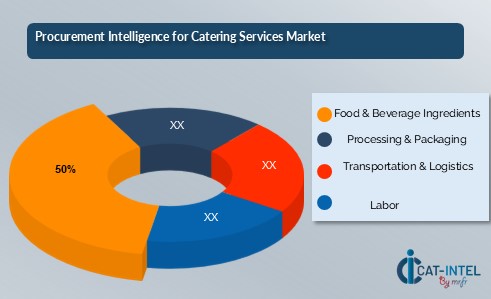
- Food & Beverage Ingredients (50%)
- Description: This represents the bulk of costs in catering, encompassing the procurement of raw ingredients, beverages, and specialty food items, including organic and locally sourced ingredients. Ingredient prices fluctuate due to market conditions, availability, and seasonality.
- Trends: Prices have risen recently due to supply chain disruptions, labour shortages, and rising commodity prices. Moreover, increasing demand for high-quality and specialty ingredients, such as plant-based alternatives, is pushing costs higher. The food service industry is also seeing price increases due to higher costs for meat and fresh produce.
- Labor (XX%)
- Processing & Packaging (XX%)
- Transportation & Logistics (XX%)
- Overheads (XX%)

- Consumer Preferences: Rising demand for personalized, gourmet, and healthy food options, driven by changing tastes and dietary needs.
- Corporate Events and Hospitality Sector: A growing number of corporate functions, conferences, and social events are expanding the need for catering services.
- Health and Wellness Trends: The increasing awareness of health-conscious eating habits is pushing demand for organic, plant-based, and dietary-specific catering options.
- E-commerce Growth: The rise of online ordering for catering services and home delivery platforms boosts demand, especially in the food service industry.
- Local and Regional Suppliers: The catering industry depends on a network of local food producers, which can fluctuate based on supply chain disruptions, seasonal availability, and food trends.
- Labor Availability: Skilled culinary staff and service professionals are essential for maintaining quality and service standards, with labour shortages affecting supply.
- Sustainability and Sourcing: The adoption of sustainable practices, such as sourcing local ingredients and reducing food waste, impacts both supply and cost structures.
- Competition and Innovation: The competitive nature of the market drives constant innovation in menu offerings and service delivery models, which influences pricing and supplier availability.
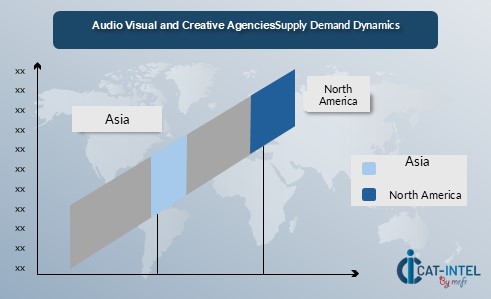
- Strong Demand for Corporate Events and Private Parties: The corporate sector in North America continues to drive catering demand, with companies increasingly outsourcing food services for meetings, conferences, and events. There's also strong demand for catering in weddings and private gatherings.
- Diverse Consumer Preferences: The region sees significant growth in demand for healthy, organic, and specialized diets, including plant-based and gluten-free options, influencing catering menus and service offerings.
- Technological Integration: The adoption of digital platforms and food delivery apps is streamlining catering operations, enhancing convenience for customers and driving growth in online catering orders.
- Sustainability Trends: U.S. caterers are embracing sustainable practices, sourcing local ingredients, and minimizing food waste to appeal to environmentally conscious consumers.
- Competitive Market: Many catering companies competing for business has led to a diverse array of services and a focus on high-quality offerings and innovation in menu and presentation.
- Hubert
- Sysco Corporation
- Ecolab
- Cater Safe Solutions
- Tetra Pak
| Category | Development | Impact | |
| Supplier Diversity | Growth in diverse supplier networks and local sourcing | Increases flexibility and resilience in catering supply chains; reduces reliance on a few large suppliers. | |
| Sustainability Focus | Adoption of sustainable sourcing practices | Reduces environmental impact, aligns with consumer demand for eco-friendly products. | |
| Technology Integration | Introduction of AI and IoT for inventory management | Enhances operational efficiency, reduces waste, and improves cost control. | |
| Health & Safety Standards | Heightened focus on food safety regulations | Ensures compliance with health codes and increases customer trust in food service providers. | |
| Cost Efficiency | Use of data analytics for procurement optimization | Improves purchasing decisions, reduces overall procurement costs by identifying the best suppliers. |
| Procurement Attribute/Metric | Details |
| Market Sizing | The global catering services market is projected to grow from USD 130.4 billion in 2023 to USD 290 billion by 2032, at a CAGR of 7.2% during the forecast period. |
| Adoption of Catering Services | Growing demand for personalized catering, including specialized dietary options (e.g., vegan, gluten-free), particularly in corporate, healthcare, and event sectors. |
| Top Strategies for 2024 | Focus on technology integration (e.g., mobile ordering), offering health-conscious meals, and incorporating sustainable sourcing practices. |
| Automation in Catering Services | Increasing use of automation in inventory management, food delivery, and event catering to enhance efficiency. |
| Procurement Challenges | Rising food costs, maintaining quality and safety, logistics management, and sustainable sourcing are key challenges. |
| Key Suppliers | Leading players include Aramark, Compass Group, Sodexo, Delaware North, Elior Group, and Newrest Group. |
| Key Regions Covered | North America, Europe, and Asia-Pacific, with growth in the US, UK, Germany, and China due to increased demand for diverse catering solutions. |
| Market Drivers and Trends | Increased demand for personalized and dietary-specific catering, sustainable practices, and significant growth in the corporate and healthcare sectors. |
Frequently Asked Questions (FAQ):
Our procurement intelligence services provide a detailed analysis of global catering service providers. We offer spend analysis, supplier performance evaluations, and market trends to ensure you find the best partners at competitive rates. These services also help identify the right suppliers based on location, pricing, and service quality, allowing you to optimize procurement strategies and achieve cost savings.
We assist in evaluating TCO by considering the entire lifecycle cost of catering services. This includes food procurement, transportation, storage, labour, and any ancillary costs like event setup or equipment rental. Understanding these costs helps ensure informed decision-making and long-term savings.
We offer risk management solutions to address potential challenges like food quality issues, delivery delays, regulatory compliance, and price volatility. Our strategies focus on building strong supplier relationships, setting clear expectations, and ensuring contingency plans are in place to mitigate supply disruptions.
Our Supplier Relationship Management (SRM) services guide you in fostering long-term, mutually beneficial relationships with catering service providers. We focus on performance management, continuous collaboration, and negotiating favourable terms to ensure consistent service quality and cost-effective solutions.
We provide actionable procurement best practices tailored to the catering market, including supplier segmentation, performance evaluation, and price negotiation strategies. These practices help you make informed, strategic decisions that align with your organization's goals and ensure competitive pricing.
Digital tools streamline the procurement process by automating workflows, enhancing data analytics, and improving supplier performance tracking. These tools also facilitate real-time communication, helping you stay responsive and agile in a dynamic catering market.
Supplier performance management ensures that catering providers meet quality, delivery, and compliance standards. We offer comprehensive tracking and evaluation tools to continuously monitor supplier performance, ensuring high service levels and reducing procurement risks.
Our insights into negotiation strategies, supported by data-driven market intelligence, help you secure favourable pricing, bulk discounts, and flexible payment terms. We also offer negotiation training to empower your team to approach suppliers with confidence.
We provide powerful market analysis tools that offer insights into global trends, supplier market share, and price forecasts. These tools help identify emerging opportunities, potential risks, and ensure that your procurement decisions are based on the latest market data.
Our solutions ensure that catering suppliers comply with local and international regulations, including food safety, hygiene standards, and health codes. We help you navigate complex regulatory environments to ensure your suppliers meet necessary certifications and standards.
We offer strategies like diversifying your supplier base, establishing backup plans, and monitoring the market for potential disruptions. These proactive measures ensure that your catering services remain uninterrupted, even in the face of supply chain challenges.
Our supplier performance tracking tools help monitor key metrics such as quality, delivery reliability, and compliance. Regular reviews and performance reports provide insights that enable you to optimize supplier selection and enhance procurement strategies.
We help identify catering service providers who adopt sustainable sourcing, waste management, and eco-friendly practices. Our sustainability assessments ensure that your procurement decisions align with your organization’s environmental goals and ethical standards.
We analyse pricing trends and market dynamics to help you benchmark catering prices and identify cost-saving opportunities. Our data-driven approach enables you to negotiate the best deals and secure competitive pricing, while maintaining high-quality service.
Our market analysis covers emerging trends like plant-based menu offerings and demand for sustainable sourcing. We also highlight risks such as fluctuations in food prices and regulatory changes. These insights help you stay ahead of market shifts and make strategic sourcing decisions.








